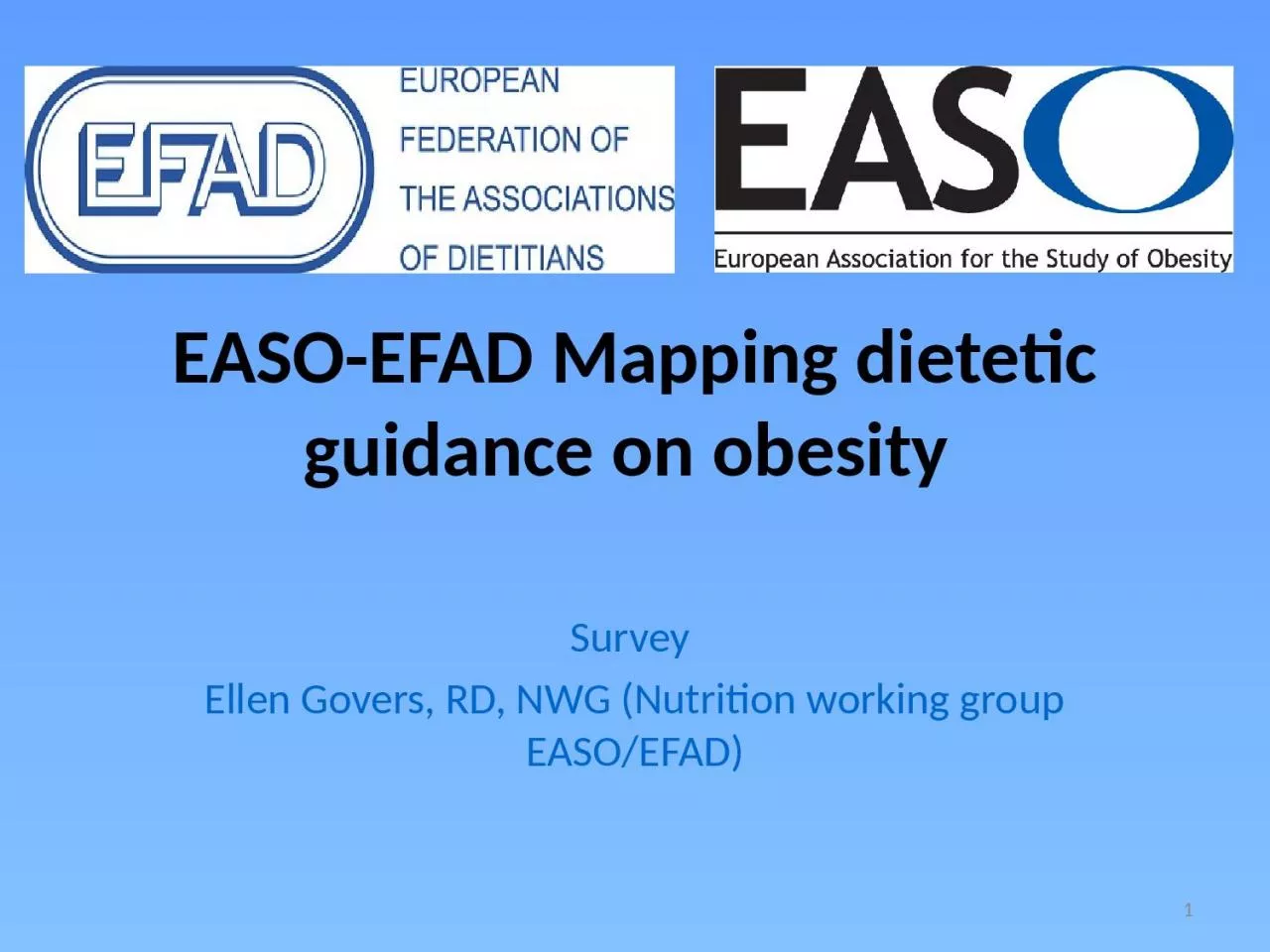

Survey Ellen Govers RD NWG Nutrition working group EASOEFAD 1 European Specialist Dietetic Network Obesity The ESDN Obesity has 6 members Maria Hassapidou Ellen Govers ID: 931859
Download Presentation The PPT/PDF document "EASO-EFAD Mapping dietetic guidance on o..." is the property of its rightful owner. Permission is granted to download and print the materials on this web site for personal, non-commercial use only, and to display it on your personal computer provided you do not modify the materials and that you retain all copyright notices contained in the materials. By downloading content from our website, you accept the terms of this agreement.
Slide1
EASO-EFAD Mapping dietetic guidance on obesity
Survey Ellen Govers, RD, NWG (Nutrition working group EASO/EFAD)
1
Slide2European Specialist Dietetic NetworkObesity
The ESDN Obesity has 6 membersMaria HassapidouEllen Govers
Tanja CallewaertHilda Mulrooney
Oddysseas Androutsos
Anthonis
Vlassopoulos
EFAD | The European Dietitians | www.efad.org | secretariat@efad.org
2
Slide3Programme
Why a questionnaire?Outcomes Conclusions
Slide4Why a questionnaire
The first questionnaire had little response.We had no insight in the methods and knowledge of dietitians treating obesity.Dietitians are a valuable source of expertise in the management of obesity which should be used to increase the quality of interventions applied in all centers where obese patients are treated. The aim of the survey
was to identify best practice by dietitians in terms of dietary intervention and to improve quality and evidence based care.Mapping
gives additional information for development
of FBDG
for
obese adults & children (phase 1 and 2).
Slide5Methods
First questionnaire to COM’s (2016)Same questionnaire + some more questions through EFAD secretariat (survey monkey) to all member associationsResponses collected, december 2016Analyses by ESDN Obesity
Slide6Outcomes
229 questionnaires were returned, of which 44 questionnaires were not fit for analysis.Exclusion criteria: absence of general information (work setting and country). 185 questionnaires were used for the analysis.
Slide7General information about thepractice: work setting
SettingNHospital
84Private practice
86
Teaching
3
Endocrinology
2
Research2
Bariatric
Surgery
2
Rehabilitation
3
Public Health
1
University
1
Prevention
1
185
Slide8Which countryCountry
NCountryNAustria
43Italy
4
Azerbajcan
1
Luxembourg
1
Belgium
10
Netherlands
5
Croatia
3
Norway
12
Cyprus
1
Poland
1
France
31
Portugal
5
Germany
3
Romania
2
Greece
10
Serbia
1
Great Britain
6
Spain
12
Hungary
9
Sweden
2
Ireland
1
Tsjec
Republik
11
Israël
1
Turkey
10
Total
185
Slide9Informationabout working experience
Years expercience in obesity managementN
YearsRangeMissing
15521,81-40
30
N
Multi-
disciplinary
MonodisciplinairyMissing160
135
35
25
Working
according
to guidelines
N
Yes
No
Missing
177
115
62
8
Additional
training in obesity management
N
Yes
No
Missing
179
137
42
6
Working
in a
multi-disciplinairy
team
Slide10Education level of dietitiansN
MeanMedianRangeMissing 1805
100-365
Number of
registered
dietitians
working per setting
Education level
N = 107
N
Bachelor
61
Masters
31
PhD
10
Unknown
5
Post HEI courses
8
Psychological/
behavioral
3
Food
technology
management
4
Slide11Patient careN
Mean Total Missing 166786
163,26019
Total number of patients treated
last
year
N
Male
Female Missing 137
32.3%
67.7%
48
Gender ratio of patients
N
Mean
Range
Missing
150
9
3-40
35
No of patients per dietitian per day
Slide12CounsellingNMeanMedianRange Missing13815
81-2547
Frequency of
counselling
visits per dietitian/year
N
Mean Median
Range
Missing
150
40
68
10-120
35
Duration of a
councelling
visit
Slide13Diagnostictools
Tool YesNoMissing Height, weight, BMI168
314Waist circumference
1195214
Bio-
impedance
11852
14Nutritional assessment165
317Quality of life
128
43
14
Psychological
assessment
115
56
14
Other
diagnostic
tools,
including
several
eating
questionnaires
were
reported
by
48 respondents; 137
answers
missing
Slide14GuidelinesGuideline
YesNoMissing National 14225
18Local/institutional
798620
Dietitian has
own
practice 9972
14Guidelines for children
10266
17
Slide15Dietary interventionsDiet N= 171
Yes No MissingDiet based on individual dietary assessment121
50 14Standard diet
23148 14
Moderate hypo
caloric
diet 32139
14Very low caloric diet 14
157 14Mediterranean
diet
52
119
14
Low
carbohydrate
/high protein
25
146
14
Low fat diet
29
142
14
Use of commercial diets: 160 respondents answered no; 16 missing
Slide16Interventionoutcomes
Intervention N= 185Yes No Missing5-15% weight loss 71
1001410% weight
loss 26145
14
BMI 25-35kg/m
2 ≥5% weight loss 28
14314
BMI >35 kg/m2 ≥10% weight loss
36
135
14
5 years weight maintenance
28
143
14
Improvement of
comorbidities
99
172
14
Improvement
of
quality
of life
108
63
14
Slide17Criteriafor effective dietary intervention
YesNo MissingAmount of weight loss
5611514
Long-term adherence131
40
14
Control of comorbidity
97 7414
Influence on body composition 99
72
14
Eating
behavior
9
-
176
Self
management
14
-
171
Slide18Weightregain percentage
N= 69 Mean MedianRange Missing
9.2%16%3-30%
116
Time
for
Weight regain to occur in years
N=
74Mean
Median
Range
Missing
4.8
5.5
1-10
111
Slide19The main barriers to diet adherence
No frequent contact with the dietitian; Lack of time; Lack of motivation; Sedentary lifestyle; Family and friends; Not having a proper lunch break; Lack of knowledge; Physiologically increased hunger and decreased satiety; Do not weigh foods anymore; Underestimate energy content in foods and overestimate energy expended by physical activity;
Fast Food; Alcoholic Drinks; Food frequency; Psychological factors; Medical condition;
Habits;Financial problems; Decrease of disturbed eating behavior and obsessive thinking about foods; Restrictive eating in itself;
Lack of awareness about inner physical cues;
Lack of adequate coping styles with stress or negative affect .
Slide20Conclusions
Dietitians specialised in obesity: The majority work in a multi disciplinary teamHave followed additional
trainingAre 33%Bsc; 16% masters; 5% PhdHave a mean of 24 years of
experience76% work according to
national
guidelines
60% also have a specific guideline for obese children
70% treat patients based on dietary assessment
Slide21Points for evaluation
Dietitians set no sharp targets for weight loss and weight maintenance (SMART)More emphasis on quality of life as weight loss outcome than on weight loss
Waist circumference is not measured
by 30%Evidence based objectives
for
weight loss management seem not clear for
many
Slide22